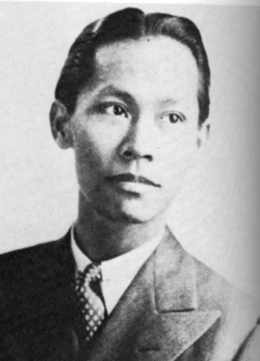Carlos Bulosan (Carlos Bulosan)

Carlos Bulosan was born to Ilocano parents in the Philippines in Binalonan, Pangasinan. There is considerable debate around his actual birth date, as he himself used several dates, but 1911 is generally considered the most reliable answer, based on his baptismal records, but according to the late Lorenzo Duyanen Sampayan, his childhood playmate and nephew, Carlos was born on November 2, 1913. Most of his youth was spent in the countryside as a farmer. It is during his youth that he and his family were economically impoverished by the rich and political elite, which would become one of the main themes of his writing. His home town is also the starting point of his famous semi-autobiographical novel, America is in the Heart. Following the pattern of many Filipinos during the American colonial period, he left for America on July 22, 1930 at age 17, in the hope of finding salvation from the economic depression of his home. He never again saw his Philippine homeland. Upon arriving in Seattle, he met with racism and was forced to work in low paying jobs. He worked as a farmworker, harvesting grapes and asparagus, and doing other types of hard work in the fields of California. He also worked as a dishwasher with his brother and Lorenzo in the famous Madonna Inn in San Luis Obispo.
Carlos Bulosan was active in labour movement along the Pacific coast of the United States and edited the 1952 Yearbook for International Longshore and Warehouse Union Local 37, a predominantly Filipino American cannery trade union based in Seattle. There is some controversy surrounding the accuracy of events recorded within America Is in the Heart. He is celebrated for giving a post-colonial, Asian immigrant perspective to the labor movement in America and for telling the experience of Filipinos working in the U.S. during the 1930s and ’40s. In the 1970s, with a resurgence in Asian/Pacific Islander American activism, his unpublished writings were discovered in a library in the University of Washington leading to posthumous releases of several unfinished works and anthologies of his poetry. His other novels include The Laughter of My Father, which were originally published as short sketches, and the posthumously published The Cry and the Dedication which detailed the armed Huk Rebellion in the Philippines. One of his most famous essays, published in March 1943, was chosen by the Saturday Evening Post to accompany its publication of the Norman Rockwell painting Freedom from Want, part of a series based on Franklin D. Roosevelt’s “Four Freedoms” speech. Maxim Lieber was his literary agent in 1944. As a labor organizer and socialist writer, he was blacklisted. Denied a means to provide for himself, his later years were of flight and hardship, probably including alcoholism.[3] He died in Seattle suffering from an advanced stage of bronchopneumonia. He is buried at Mount Pleasant Cemetery on Queen Anne Hill in Seattle.
Born
- November, 24, 1913
- Philippines
- Binalonan, Pangasinan
Died
- September, 09, 1956
- USA
- Seattle, Washington
Cause of Death
- bronchopneumonia
Cemetery
- Mount Pleasant Cemetery
- Seattle, Washington
- USA



